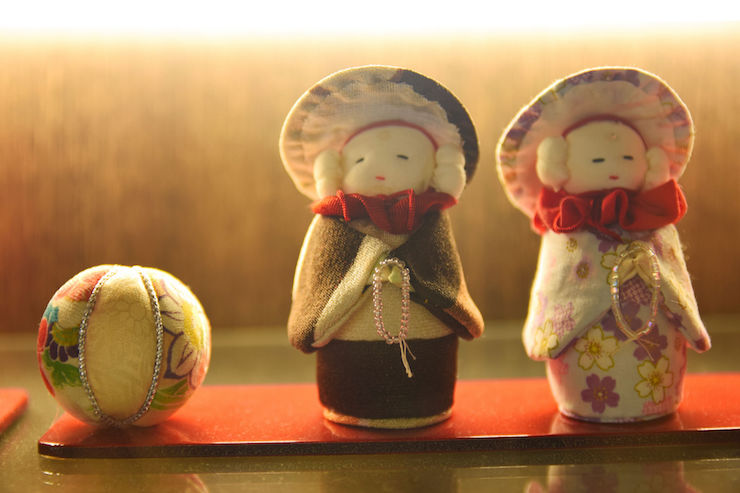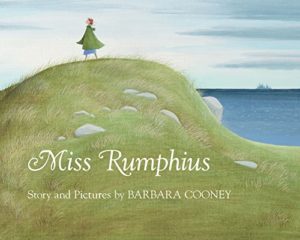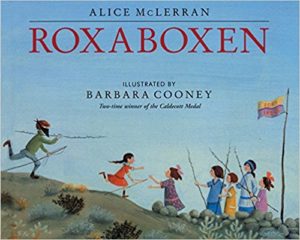I have a secret to share: This summer I read countless children’s picture books to myself—not just once, but several times, even at bedtime.
There’s more. I have a children’s-book buddy. (It surprised me, too.) It’s like a poetry buddy, but we read children’s picture books instead of poems.
What encouraged this surprising turn of events? Here’s how it went down.
One day I heard a gentle thump on our foyer’s tile floor, followed by the click of the dead bolt as my husband headed out for the afternoon.
What was that?
I approached the front door and found a box, its Amazon smile tempting me. I didn’t recall ordering anything, but carried the box to the kitchen, sliced through the packing tape, and pulled back the ends. Nestled inside was a calming sea of color: ocean blues, waves of white, and laurel green hills. I picked Miss Rumphius from the pile, a picture book written by Barbara Cooney.
Children’s books? Were these delivered to the wrong address?
I read the shipping label; it showed my name and address. Then I searched through the box until I found this note: “A gift for you. For your creativity, Sharon. The sea is calling. Warmly, Laura.”
Now I understood. The books were treasures given in preparation for my upcoming Artistic Jumpstart coaching with Laura Barkat.
I couldn’t resist the opportunity to abandon my to-do list and read Miss Rumphius aloud to myself. It made me feel like the freckle-faced girl I once was, with a pixie haircut and missing front teeth—comforted and somehow cared for.
Now the story shifts to Megan Willome and an app called Voxer. Megan and I became friends through the Tweetspeak writing workshops she taught. As one course neared completion, we voiced a mutual desire to stay in touch. It only seemed natural to invite her to Voxer, a voice-based messenger app. She accepted.
Our conversations began with personal updates about summer plans and the differences between our springs—hers in Texas and mine in Maine. Then one day I pressed Voxer’s orange button and voiced my insights about Miss Rumphius. I told her how Laura had suggested I look at the structures and patterns of children’s stories.
“Do you know much about frames and layers of story?” I asked.
Megan borrowed Miss Rumphius from her local library, and our exchange ensued. I had never plunged so deeply into a story’s meanings beyond what was on the page. Soon, one of us said something like, “Let me know if you come across another picture book you like.” And the buddying began.
Barbara Cooney wrote, “A picture book is like a string of beads with the illustrations being the jewels, but the text is the string that holds them all together.” That’s what has guided Megan and me ever since. We share each jewel and string, one book at a time. Now we’re exploring I’m In Charge of Celebrations by Byrd Baylor.
The Initial Reading Process
During my first read-through, I focus on general observations and feelings the story evokes. With subsequent readings I pull the story apart like a puzzle, sorting pieces by concepts, images, and sounds. Many children’s books carry both the craft and magic of poetry, so it seemed natural to pull out my copy of How to Read a Poem by Tania Runyan. Just as I explore a poem, I unwrap a children’s story — opening my senses, lingering along lines, and “feeling for the light switch.”
4 Ways to Go Farther With a Buddy
1. Find Connection
Incoming messages from my buddy feel like the letter in my mailbox I can’t wait to unfold. A text message about a particular book pops into my Voxer feed: “I’ve got issues.” I chuckle because I now know Megan well enough to get her.
Buddying has also brought us and our stories together. Courage by Bernard Waber generated conversations about our personal experiences with courage. We agree that we both sometimes “do things scared,” because courage is not without fear.
2. Be More Curious
Like many children’s stories, Maurice Sendak’s Where the Wild Things Are is a book filled with curiosity. The more Max wonders, the bigger his world becomes. The ceiling grows leaves. Bedposts become a forest. The floor transforms to flora. He goes on a journey and meets monsters. They have a wild rumpus!
Just like Max, we can use our imagination and mentally go wherever our curiosity leads us and find adventure and discovery.
When I read about Max with a buddy, the story provoked curiosity questions like:
“Are the monsters a metaphor for anything?”
“What do the monsters help Max do?”
“What is my wild thing?”
“What can I learn from Max?”
3. Be More Creative
Children’s picture books may be less about finding the right answers and more about asking the right questions. Sometimes Megan and I think differently, and as we share and ask questions, we discover new ideas. One of us will say, “I would never have noticed how the lines break,” or “I didn’t see how those elements served as bookends.” Learning from each other makes us more creative.
Megan discovered Martina, the Beautiful Cockroach: A Cuban Folktale by Carmen Agra Deedy. Sprinkled with Spanish, it explores love, family roots, and traditions in ways I had not considered. I found a fun online reading from a library near Megan’s neck of the woods. Later, she sent me the link to a song in Spanish and English — another way to fuel my creativity, with continued learning.
Paying attention to detail in Martina made us more creative as we considered how the story works and how the illustrations may have come about. We looked at literary terms, word choices, repetitions, framing, and themes. It may sound weighty, but our discussion was light and lively. We noticed Michael Austin’s illustrations — a thread spool acts as a stool, a silver spoon serves as a mirror, and a postage stamp hangs as wall art. When it comes to being creative, sometimes what we’re looking for is already there. We just have to see it.
4. Acquire Knowledge
Reaching into children’s books allows us to learn about ourselves, others, and the world. We gain knowledge about history, other cultures, and divergent perspectives. In other words, we apply our curiosity to the pursuit of knowledge.
Katherine Applegate’s historically-based picture book, The Buffalo Storm, encouraged me to examine not only the story arc but also the life of a pioneer girl like Hallie. My research taught me that buffalo storms and Hallie’s other experiences along the Oregon Trail were likely pretty common. This vivid story has its tense moments. Many exchanges later, I told Megan I was “all buffaloed out!”
A Final Note
Children’s book buddying has allowed me to see with the eyes of a child. It now motivates my weekly visits to the library, where I explore child-sized shelves and listen to new readers sound out words as I thumb through books. I leave, my arms filled with books like a kid with an armful of toys. (Did I tell you I put my name in to read at Story Hour?)
I like to think we’re all still children at heart, like the children who never forgot the rocky hill where they entered an imaginary world, the place they called Roxaboxen. Maybe Roxaboxen by Alice MeLerran should be our next selection. After all, there is so much to talk about.
Photo by Raita Futo, Creative Commons, via Flickr. Post by Sharon A. Gibbs.
- 5 Reasons You Should Read Aloud (Maybe Even to Your Pets!) - November 17, 2017
- 4 Great Reasons To Read Kids’ Books—With a Book Buddy! - September 8, 2017



Bethany R. says
“I couldn’t resist the opportunity to abandon my to-do list and read Miss Rumphius aloud to myself. It made me feel like the freckle-faced girl I once was, with a pixie haircut and missing front teeth—comforted and somehow cared for.”
What a delightful post. Love the idea of taking in children’s books on a deeper level. I have read heaps of them with my kiddos and some certainly stand out more than others. Zeroing in on the illustrations as well as the text offers all kinds of opportunities for noticing the layers of a story. Roxaboxen looks like a lively one. I don’t think I’ve read it—yet.
L.L. Barkat says
Oh, Roxaboxen is a must-read. It’s about those childhood worlds we created that helped create us (and stay alive in memory).
Sharon A Gibbs says
I agree. So many lovely layers to explore in this one.
Sharon A Gibbs says
Bethany, 🙂 Looking for layers in a story is like going on a treasure hunt and returning with an armful of jewels to share. I love how it enriches the conversations—even for grown ups.
“Roxaboxen” is one of my favorites. Let me know what you think.
Michelle Ortega says
Sharon! Thanks for taking us on this journey with you. I like to think we are all children at heart, too, in search of wild things. Wonderful read!
Sharon A Gibbs says
Thanks, Michelle! Reading kids’ books helped me tap into that wondrous, creative, and curious world where children live. (And I found a few wild things, too!)
L.L. Barkat says
Sharon, I wonder if you (and Megan 🙂 ) find that children’s books can help you approach topics you might otherwise have a harder time approaching?
Visualization is of course a thing, for helping a person make strides. So I’m wondering if the books sort of give the chance to enter into problem solving and discoveries by providing some ready-made visualizations.
Sharon A Gibbs says
An absolute and wholehearted “Yes!”
Interestingly, a children’s book helped me cope with a difficult event in May, and the emotions that followed. The message from this particular book has etched a permanent place in my heart—a message that helped expand my vision of that moment.
My library’s copy of “What Do You Do with a Problem?” by Kobo Yamada sits on my nightstand. Without dishing any spoilers, I can say that this book addresses your question. It is certainly worth a look.
Megan, how about you?
Megan Willome says
My answer is, No more than usual. Meaning I approach everything hard through fiction. Children’s books are a shorter read, and like poetry, often do more heavy lifting with fewer words.
Debra Hale-Shelton says
I’m going to the library’s children’s section this weekend. Thank you, Sharon, for sharing this reading adventure with others.
Sharon A Gibbs says
Deb, that makes me happy. Reading children’s books lights the way to see the world differently–and with brighter curiousity and creativity. Have fun! (And keep me posted.) 🙂
Katie says
tile, ink
brilliant colors
vivid words and pictures
bring the whole alphabet to life
well played
Sharon A Gibbs says
Katie, How creative! I love your poems!
Katie says
Thank you, Sharon:)
Katie says
gray day
no way, not here
children will take joy in
poetic language of colors
let’s read!
Mary Van Denend says
Sharon, thanks for sharing your re-discovery of picture books with the readers here. I too am a great fan of all kinds of children’s books. I have a leaning tower bookshelf of them in the upstairs hallway. So when my grandchildren come to visit there’s a shelf for every age, size, and interest level. Barbara Cooney included. What would we do without “The Oxcart Man?” Such a perfect blend of great poetry (Donald Hall), American history, and Cooney’s wonderful illustrations. Another favorite children’s writer for me is Cynthia Rylant (When I Was Young in the Mountains). I just bought her “All in a Day” with exquisite black & white illustrations by Nikki McClure. It’s not a new book but it was new to me!
Sharon A Gibbs says
I love everything Barbara Cooney, including “The Oxcart Man.” I’ll have to look for Cynthia Rylant. Thank you for the suggestion.
I recently finished another wonderful read, “The One and Only Ivan” by Katherine Applegate. It’s been so much fun recommending good reads to mothers of littles.